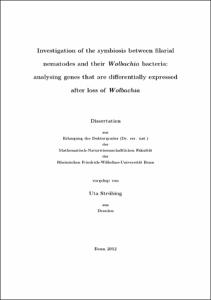Strübing, Uta: Investigation of the symbiosis between filarial nematodes and their Wolbachia bacteria: analysing genes that are differentially expressed after loss of Wolbachia. - Bonn, 2012. - Dissertation, Rheinische Friedrich-Wilhelms-Universität Bonn.
Online-Ausgabe in bonndoc: https://nbn-resolving.org/urn:nbn:de:hbz:5n-30615
Online-Ausgabe in bonndoc: https://nbn-resolving.org/urn:nbn:de:hbz:5n-30615
@phdthesis{handle:20.500.11811/5416,
urn: https://nbn-resolving.org/urn:nbn:de:hbz:5n-30615,
author = {{Uta Strübing}},
title = {Investigation of the symbiosis between filarial nematodes and their Wolbachia bacteria: analysing genes that are differentially expressed after loss of Wolbachia},
school = {Rheinische Friedrich-Wilhelms-Universität Bonn},
year = 2012,
month = nov,
note = {Filarial infections, caused by Brugia malayi, Wuchereria bancrofti and Onchocerca volvulus are a worldwide health problem in developing countries, causing elephantiasis or dermatitis and blindness. 1.3 billion people live at risk of infection. Current mass drug administration programmes with ivermectin, diethylcarbamazine and albendazole prevented many cases of disease, nevertheless, as they are only microfilaricidal they have to be given over many years to stop transmission. Targeting the essential Wolbachia endobacteria with doxycycline has been proven to be an effective therapy, as worm development and survival of adult worms is greatly reduced without the endosymbiont. However, doxycycline is contraindicated for a large portion of the at risk population.
My work aimed to analyse the molecular interactions between filaria and their endosymbiotic Wolbachia in order to promote target identification for new drugs against filariasis. The B. malayi microarray was used in a cross-species hybridisation experiment to identify genes that are differentially expressed in Litomosoides sigmodontis after depletion of Wolbachia and therefore might have a role in symbiosis. The microarray data were filtered for regulated genes with a false discovery rate ≤ 5 % and a ≥ 2-fold change. Most of the genes were differentially expressed at day 36 of tetracycline treatment, when 99.8 % of Wolbachia were depleted. Several classes of genes were affected, including genes for general processes like translation, transcription, post-transcriptional processing and folding/sorting of proteins and also genes involved in motility, structure and signalling pathways. L. sigmodontis specific quantitative PCR validated ∼ 60 % of the genes found to be regulated in the microarray.
Interestingly, most of the mitochondrial encoded subunits of respiratory chain complexes containing heme and riboflavin were up-regulated. No change in the expression of these genes was seen in tetracycline treated Wolbachia-free Acanthocheilonema viteae. As Wolbachia synthesise heme and filaria do not, we hypothesise that without the endosymbionts no functional heme-containing enzymes can be formed, leading to loss of energy metabolism which then results in up-regulation of the mitochondrial encoded subunits in an attempt to correct the deviation from homeostasis. A nuclear encoded heme-binding protein of the globin family was also up-regulated, therefore the differential expression of heme proteins after Wolbachia depletion was not limited to the mitochondria. Using a filarial ex vivo culture, established as part of my thesis work, we confirmed that Wolbachia-containing L. sigmodontis worms were sensitive to inhibition of the heme biosynthesis pathway, whereas Wolbachia-free worms were not affected by the same treatment. The results indicate that filarial nematodes are dependent on the heme provided by their essential Wolbachia and support further targeting the Wolbachia heme synthesis pathway for the discovery of new anti-filarial drugs.},
url = {https://hdl.handle.net/20.500.11811/5416}
}
urn: https://nbn-resolving.org/urn:nbn:de:hbz:5n-30615,
author = {{Uta Strübing}},
title = {Investigation of the symbiosis between filarial nematodes and their Wolbachia bacteria: analysing genes that are differentially expressed after loss of Wolbachia},
school = {Rheinische Friedrich-Wilhelms-Universität Bonn},
year = 2012,
month = nov,
note = {Filarial infections, caused by Brugia malayi, Wuchereria bancrofti and Onchocerca volvulus are a worldwide health problem in developing countries, causing elephantiasis or dermatitis and blindness. 1.3 billion people live at risk of infection. Current mass drug administration programmes with ivermectin, diethylcarbamazine and albendazole prevented many cases of disease, nevertheless, as they are only microfilaricidal they have to be given over many years to stop transmission. Targeting the essential Wolbachia endobacteria with doxycycline has been proven to be an effective therapy, as worm development and survival of adult worms is greatly reduced without the endosymbiont. However, doxycycline is contraindicated for a large portion of the at risk population.
My work aimed to analyse the molecular interactions between filaria and their endosymbiotic Wolbachia in order to promote target identification for new drugs against filariasis. The B. malayi microarray was used in a cross-species hybridisation experiment to identify genes that are differentially expressed in Litomosoides sigmodontis after depletion of Wolbachia and therefore might have a role in symbiosis. The microarray data were filtered for regulated genes with a false discovery rate ≤ 5 % and a ≥ 2-fold change. Most of the genes were differentially expressed at day 36 of tetracycline treatment, when 99.8 % of Wolbachia were depleted. Several classes of genes were affected, including genes for general processes like translation, transcription, post-transcriptional processing and folding/sorting of proteins and also genes involved in motility, structure and signalling pathways. L. sigmodontis specific quantitative PCR validated ∼ 60 % of the genes found to be regulated in the microarray.
Interestingly, most of the mitochondrial encoded subunits of respiratory chain complexes containing heme and riboflavin were up-regulated. No change in the expression of these genes was seen in tetracycline treated Wolbachia-free Acanthocheilonema viteae. As Wolbachia synthesise heme and filaria do not, we hypothesise that without the endosymbionts no functional heme-containing enzymes can be formed, leading to loss of energy metabolism which then results in up-regulation of the mitochondrial encoded subunits in an attempt to correct the deviation from homeostasis. A nuclear encoded heme-binding protein of the globin family was also up-regulated, therefore the differential expression of heme proteins after Wolbachia depletion was not limited to the mitochondria. Using a filarial ex vivo culture, established as part of my thesis work, we confirmed that Wolbachia-containing L. sigmodontis worms were sensitive to inhibition of the heme biosynthesis pathway, whereas Wolbachia-free worms were not affected by the same treatment. The results indicate that filarial nematodes are dependent on the heme provided by their essential Wolbachia and support further targeting the Wolbachia heme synthesis pathway for the discovery of new anti-filarial drugs.},
url = {https://hdl.handle.net/20.500.11811/5416}
}






